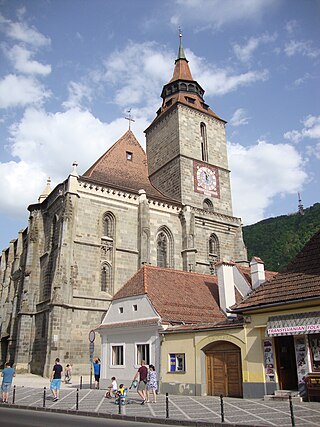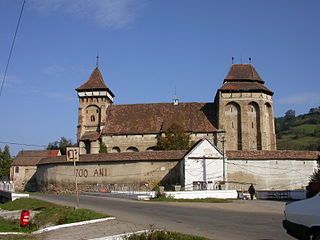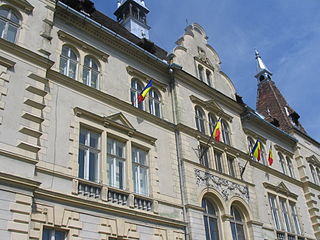
Brașov County is a county (județ) of Romania, in Transylvania. Its capital city is Brașov. The county incorporates within its boundaries most of the Medieval "lands" (țări) Burzenland and Făgăraș.

Sibiu County is a county of Romania, in the historical region of Transylvania. Its county seat is the namesake town of Sibiu.

Mureș County is a county (județ) of Romania, in the historical region of Transylvania, with the administrative centre in Târgu Mureș. The county was established in 1968, after the administrative reorganization that re-introduced the historical judeţ (county) system, still used today. This reform eliminated the previous Mureș-Magyar Autonomous Region, which had been created in 1952 within the People's Republic of Romania. Mureș County has a vibrant multicultural fabric that includes Hungarian-speaking Székelys and Transylvanian Saxons, with a rich heritage of fortified churches and towns.

The Olt is a river in Romania. It is 615 km (382 mi) long, and its basin area is 24,050 km2 (9,290 sq mi). It is the longest river flowing exclusively through Romania. Its average discharge at the mouth is 174 m3/s (6,100 cu ft/s). Its source is in the Hășmaș Mountains of the eastern Carpathian Mountains, near Bălan, rising close to the headwaters of the river Mureș. It flows through the Romanian counties Harghita, Covasna, Brașov, Sibiu, Vâlcea, and Olt. The river was known as Alutus or Aluta in Roman antiquity. Olt County and the historical province of Oltenia are named after the river.

The Hârtibaciu is a river in the Transylvania historical region of Romania. It develops in the South Carpathians and flows into the Cibin, a tributary of the Olt, in Mohu, southeast of Sibiu. It flows through the towns and villages Bărcuț, Retiș, Brădeni, Netuș, Agnita, Benești, Alțâna, Nocrich, Hosman, Cornățel and Cașolț. Its length is 110 km (68 mi) and its basin size is 1,025 km2 (396 sq mi).

Miercurea Sibiului is a town in the west of Sibiu County, in southern Transylvania, central Romania, 34 km (21 mi) to the west of the county capital, Sibiu.

Cetatea de Baltă is a commune in Alba County, Transylvania, Romania. The commune is composed of four villages: Cetatea de Baltă, Crăciunelu de Sus, Sântămărie and Tătârlaua.

Șura Mică is a commune in the central part of Sibiu County, Transylvania, Romania. The commune is located immediately to the north of the city of Sibiu. It is composed of two villages, Rusciori and Șura Mică.

Valea Crișului is a commune in Covasna County, Transylvania, Romania composed of two villages:

Bunești is a commune in Brașov County, Transylvania, Romania. It is composed of five villages: Bunești, Criț, Meșendorf, Roadeș, and Viscri. Each of these has a fortified church.

Șura Mare is a commune located in Sibiu County, Transylvania, Romania. It is composed of two villages, Hamba and Șura Mare. Șura Mare was first mentioned in 1332, and Hamba in 1337.

Șeica Mare is a commune located in Sibiu County, Transylvania, Romania. It is composed of six villages: Boarta, Buia, Mighindoala, Petiș, Șeica Mare, and Ștenea. Calvaser was also a village until the late 20th century, when it was absorbed by Șeica Mare village.

Valea Viilor is a commune located in Sibiu County, Transylvania, Romania. It has a population of 2,034, and is composed of two villages, Motiș and Valea Viilor. Each of these has a fortified church, Motiș fortified church and Valea Viilor fortified church. Both places were established and long inhabited by Transylvanian Saxons.

Apold is a commune in Mureș County, Transylvania, Romania. It is composed of four villages: Apold, Daia, Șaeș, and Vulcan.

The Evangelical Church of the Augsburg Confession in Romania is a German-speaking Lutheran church in Romania, mainly based in Transylvania. As a Lutheran church, it adheres to the Augsburg Confession. Its history goes back to the 12th century when the Transylvanian Saxons arrived in the region, then part of the Kingdom of Hungary.

The Târnava Mare is a river in Romania. Its total length is 223 km (139 mi) and its basin size is 3,666 km2 (1,415 sq mi). Its source is in the Eastern Carpathian Mountains, near the sources of the Mureș and Olt in Harghita County. It flows through the Romanian counties of Harghita, Mureș, Sibiu, and Alba. The cities of Odorheiu Secuiesc, Sighișoara, and Mediaș lie on the Târnava Mare. It joins the Târnava Mică in Blaj, forming the Târnava.

Alba County is a county (județ) of Romania located in the historic region of Transylvania. Its capital is Alba Iulia, a city with a population of 63,536.

The Valea Viilor fortified church is a Lutheran fortified church in Valea Viilor (Wurmloch), Sibiu County, in the Transylvania region of Romania. It was built by the ethnic German Transylvanian Saxon community at a time when the area belonged to the Kingdom of Hungary. Initially Roman Catholic, it became Lutheran following the Reformation. Together with the surrounding village, the church forms part of the villages with fortified churches in Transylvania UNESCO World Heritage Site.

Târnava-Mare County is one of the historical counties of the Kingdom of Romania, in the historical region of Transylvania. The county seat was Sighișoara.


































